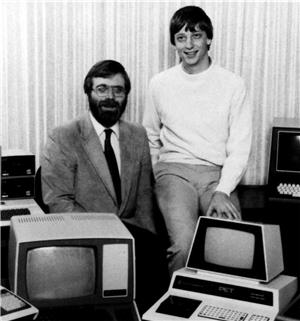In the fall of 1975, William Gates III (b. 1955) and Paul Allen (1953-2018) form the company that grows into Microsoft.
The Microsoft odyssey began with the Altair 8800: a small, rectangular box that had no keyboard or screen and didn't do much more than blink. A mockup appeared on the cover of the January 1975 issue of Popular Electronics, with a headline hailing the "World's First Minicomputer Kit to Rival Commercial Models." For the teenaged Bill Gates and his high school buddy Paul Allen, the Altair -- named after a distant star in the constellation Aquila -- pointed the way to a dazzling future.
Bill Gates and Paul Allen were friends who had begun working on computers together at the Lakeside School, a private school in Seattle. In 1975, Gates was at Harvard and Allen was working as a computer programmer in Boston, where he had gone so that he and Gates could continue working together.
It was Allen who spotted the story about the new microcomputer in Popular Electronics. The Altair 8800, available in kit form for $397, had only 256 bytes of memory (a byte represents a single character). "You could get the lights on the front panel to blink, but that was about all," Gates recalled (Gates, 16). Nonetheless, Gates and Allen were convinced that there would be a market for software for the Altair and the other desktop computers they believed would follow it. For the next eight weeks, the two worked feverishly to adapt a version of an existing computer language called BASIC (Beginner's All-purpose Symbolic Instruction Code) for the Altair.
By the fall of 1975, they had officially "shipped" (released) their program, licensed it to Altair's manufacturer, and formed Micro-soft. (They dropped the hyphen one year later.)

